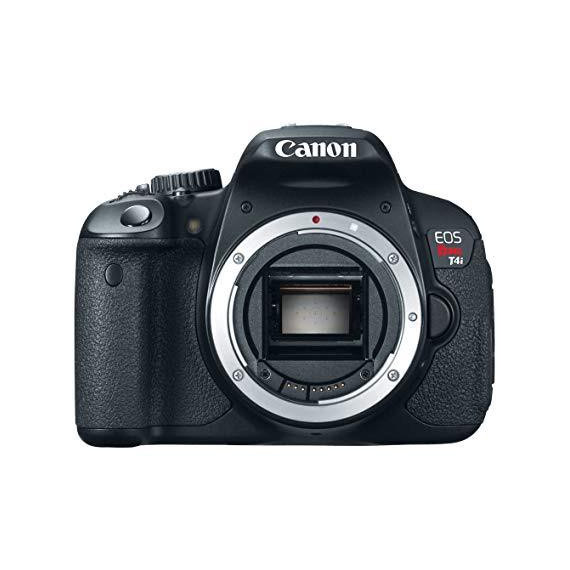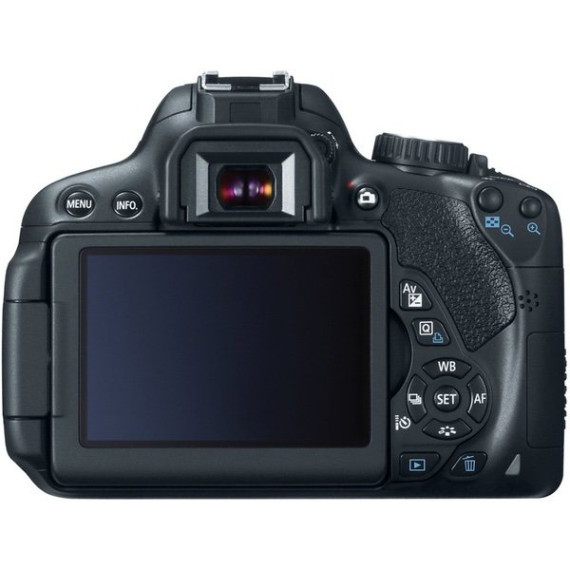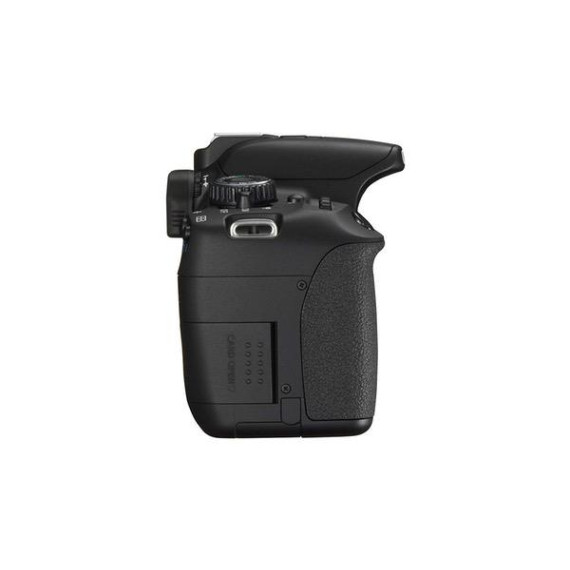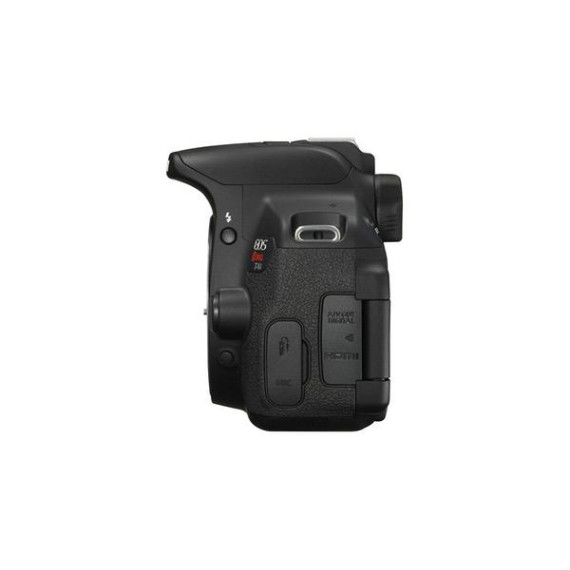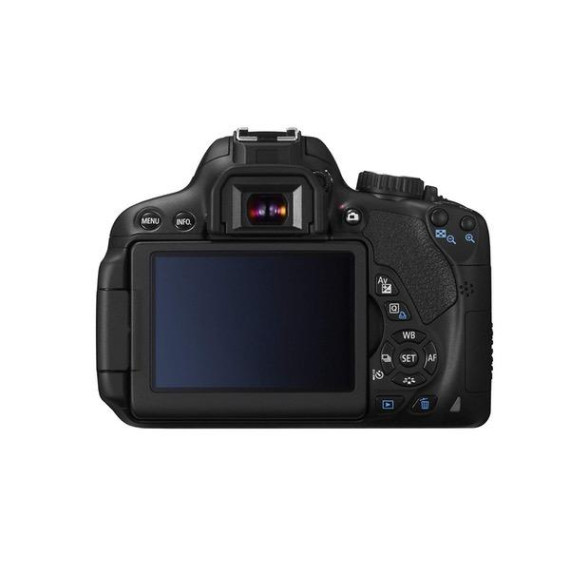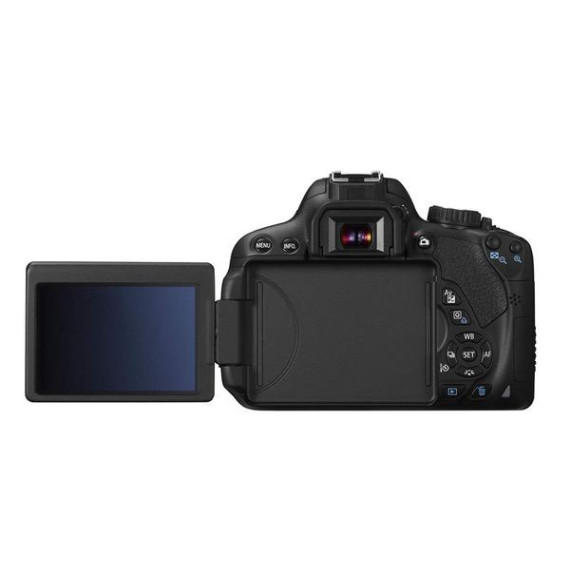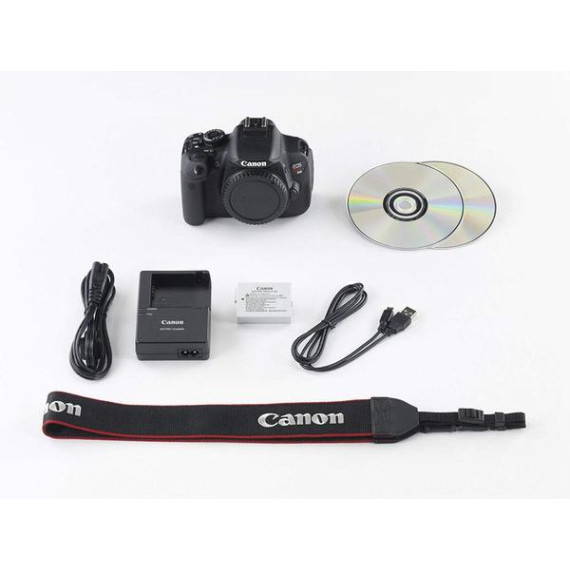E. Reed
I had this long awesome review and Amazon lost it of course. So here goes a second try. This is my second Canon camera. Previously I have owned Olympus and Minolta cameras. I owned a t2i before this and used a t3i for weeks for testing purposes. I will try to cover most aspects of the new features and image quality. For testing purposes I used a Canon 17-40L lens. Look and Feel: Not much to say here for the look of the camera. Looks almost the exact same as the t2i, t3i. The battery grip and accessories all fit the same. One thing that is different from the t2i is the proximity sensor. On the t2i it was below the optical viewfinder and above the screen. On the t4i it is above the optical viewfinder. I use an eyecup(http://www.amazon.com/gp/product/B003Y06336)and it used to make the screen shut off on its own regularly on the t2i. This is a non issue for the t4i. There is also an added dedicated movie button in the power switch now. Feel is a little different. The t4i feels more sturdy than the previous two rebels. The buttons are more solid and the selector wheels are improved. The adjustment wheel has better clicks and dont feel like you could easily flick it and change a setting by accident. The mode selector wheel is sturdier as well. I notice this because my t2i used to regularly switch to A-DEP mode when I would pull the camera out of my bag and I would get upset if I missed a quick shot because of it. I feel this will be a non issue with the new model. One issue I have is using my eyecup mentioned previously. The flippy screen catches on this and is just a slight annoyance but not a huge deal in the grand scheme. The rebel series always felt a bit small in the hand for me so I now use a battery grip which adds weight and substance to the camera. Touchscreen: When I saw rumors that the t4i would have a touchscreen I first said I wouldnt buy it. I figured this would be a gimmick and offer limited functionality. Then when i saw the press release and videos from Canon I changed my mind. I was sceptic of a couple things I will address here. I will start with the touch to adjust. Right now I feel kind of wonky using the touchscreen to make most adjustments to shooting in manual mode which is all i shoot in. But I consider this like moving from a blackberry to an iPhone. You are used to using buttons and the keyboard for so long you are lost on the touchscreen at first, but with time it ends up faster and easier. So in time it will end up faster for me to adjust by touch I am sure. It is in two spots already. ISO adjusting always seemed kind of odd to me on the rebel. The ISO button was placed so you had to kind of search for it and then do a three button combo to set it. On the touchscreen I find this easier. A couple taps and its done. The other major place its easier for me is AEB. Bracketing on Canon is typically a pain. Hit menu, find the exposure selector, hit OK. Slide the wheel, hit OK again then press menu. On touchscreen you just press the exposure and tap a couple times to set the bracket. Touch to focus was something that I didnt see coming from Canon. When they announced it my thought was it would be OK but nothing great. I figured it would be where you would touch on one of the 9 AF points you would like the camera to use. But thanks to the hybrid CMOS on the camera, it is truly a touch to focus. No matter where in the frame you press the camera will seek out and quickly focus on that area. This function works much better than I anticipated and I may use it in the future. At first I figured this would be a selling point for soccer moms but I was incorrect. I have not used the face detection follow focus to comment on it yet. Image Quality: This is the most important thing in the end when you buy any camera. How will my images look? The t4i does not disappoint. Thanks to improvements in the processor, focus, sensor and noise reduction software the t4i simply crushes the previous rebel cameras. We can start with the White balance. On the previous rebels and even the 60d, white balance was not so great. A yellow or tan-ish hue was almost always present and reds were soft. Canon has addressed this issue and images are clear and cary a nice contrast throughout the image. Auto focus I have touched on. Moving from 1 to 9 cross type AF points and a new added contrast detection sensor for AF makes a world of difference. Focus is fast and true and doesnt waste time seeking as much as before. In live view mode in low light, the digic4 and old sensors were pretty bad. A lot of seeking and misplaced focal areas. This is greatly improved with this model. Because of these reasons if you shoot in auto focus or any auto mode on the camera your images will turn out better. Low Light/High ISO: When the digic 5 was announced Canon touted this as being able to provide up to 75% better image quality over the digic 4. Of course I didnt buy into this because its Canon and they were there to sell you. With the t4i Canon added the digic 5 as well as some new noise reduction software to boot. How did it make out? I tested these things against a Canon 60D. Same lens, same settings. In RAW at ISO 6400 the image quality looked at least twice as good over the 60D in terms of noise. At 12800 its laughable. That being said, on my t2i I would not use an image over ISO 1600 to print or display or sell. On the t4i I would gladly use ISO 3200 and at times 6400. Auto focus is so much improved at high ISO and low light that its one of the first things you notice when comparing the camera to the 60D. Battery life: Have not used it a full day to test yet. I imagine if you use full time AF it will go down slightly from the previous models. Other Additions: Scene Intelligent Auto....Used for one shot. Seemed to be OK but I am a manual shooter. I am sure this would work well for most beginners. Handheld Night Scene....This takes 4 quick shots in a row and then in the camera combines them to reduce shake and noise. At 6400 ISO the image did result in less noise over standard shooting in RAW. This mode can only be done in JPG. I can see it being very good indoors at functions or for quick night shots outside. HDR Backlight Control....This will do in camera HDR. It takes three shots of various exposure and combines them to improve highlight and shadow detail.This worked well and didnt produce too much noise in low light. It does not produce an image that people now days think of in HDR with blown out tones and surreal feeling to it. It is more traditional in where it just makes shadows appear less and corrects some blowing out by brighter lights in a frame. Works well for what its supposed to be. Also only available in JPG Autofocus during video...Worked well and somewhat fast with my 17-40. Still allowed some noise from the lens searching for focus, but I wasnt using one of the STM lenses designed for this function. EDIT: Since my initial review I have had a chance to test video with an STM lens and try out the face follow focus. The STM lens does improve focus speed quite a bit in video and is much quieter. There is still a little noise but may be something you dont notice depending on the scene you are shooting. Face follow focus works better than I thought it would. It can actually focus on an object as well as just faces. It follows through the frame very well and precise even in low light. Its nto super fast to focus but still works well. PROS: Outstanding Image Quality. Even at higher ISO Touchscreen Ease Of Use 5 Frames Per Second Shooting Auto Focus CONS: Built in stereo mic is kind of pointless unless you use an STM lens. Maybe even then. The bezel around the touchscreen is uneven, but that has nothing to do with function. Its just poor design. Learning curve on the touchscreen Feature guide...It makes touchscreen control unbearable. Just disable it as soon as you turn the camera on and save yourself the frustration of being told why you need to change ISO every time you touch the button for it. FINAL WORD: If you were holding back or looking for a reason to upgrade your digic 4 based camera this is the one you are looking for. Compared to the t2i/t3i/60D this camera will offer you better image quality, focus, low light performance and ease of use. Yes the 60D is an "upgrade" over the rebel line but as of now, youd only gain size, weight and one stop of shutter speed over the t4i with the 60D. With the t4i youd gain better images, video, high ISO performance, touchscreen, shutter lag and a few other things. This camera offers many new technologies and additions from Canon that arent seen on any other camera in their line up. If you are a beginner or someone with a previous rebel looking for a nice camera you will find this camera to offer many things that you will enjoy in a first camera or an upgrade. This camera can make your photos better by taking the same photos as you would have with the previous models just with the improvements and that is what you should look for. The t3i was a small upgrade form the t2i and Canon has made up for it with this rebel. If you do own or buy this camera join the flickr group we have made. It can be found at Flickr /groups/canont4i/




